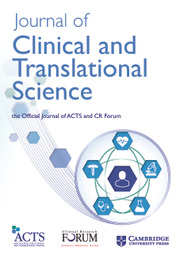No CrossRef data available.
Article contents
104 Using noninvasive bioaerosol sampling to characterize human-to-human transmission of influenza virus in a controlled exposure setting
Published online by Cambridge University Press: 11 April 2025
Abstract
Objectives/Goals: Mathematical models of airborne virus transmission lack supporting field and clinical data such as viral aerosol emission rates and airborne infectious doses. Here, we aim to measure inhalation exposure to influenza aerosols in a room shared with persons with community-acquired influenza and estimate the infectious dose via inhalation. Methods/Study Population: We recruited healthy volunteer recipients and influenza donors with polymerase chain reaction (PCR)-confirmed community-acquired infection. On admission to a hotel quarantine, recipients provided sera to determine baseline immunity to influenza virus, and donor infections were confirmed by quantitative real-time polymerase chain reaction. Donors and recipients were housed in separate rooms and interacted in an “event room” with controlled ventilation (0.2 – 0.5 air changes/hour) and relative humidity (20–40%). We collected ambient bioaerosol exposure samples using NIOSH BC-251 samplers. Donors provided exhaled breath samples collected by a Gesundheit-II (G-II). We analyzed aerosol samples using dPCR and fluorescent focus assays for influenza A and sera by hemagglutinin inhibition assay (HAI) against donor viruses and vaccine strains. Results/Anticipated Results: Among two cohorts (24b and 24c), we exposed 11 recipients (mean age: 36; 55% female) to 5 donors (mean age: 21; 80% female) infected with influenza A H1N1 or H3N2. Eight G-II and two NIOSH bioaerosol samples (1–4 µm and ≥4 µm) were PCR positive. We cultured virus from one G-II sample. Based on previous literature, we hypothesized that ~50% of immunologically naïve people (HAI Discussion/Significance of Impact: We demonstrated that it is feasible to recruit donors with community-acquired influenza and expose recipients to measurable virus quantities under controlled conditions. However, baseline immunity was high among volunteers. Our work sets the stage for designing studies with increased sample sizes comprising immunologically naïve volunteers.
Information
- Type
- Biostatistics, Epidemiology, and Research Design
- Information
- Creative Commons
- This is an Open Access article, distributed under the terms of the Creative Commons Attribution-NonCommercial-NoDerivatives licence (https://creativecommons.org/licenses/by-nc-nd/4.0/), which permits non-commercial re-use, distribution, and reproduction in any medium, provided the original work is unaltered and is properly cited. The written permission of Cambridge University Press must be obtained for commercial re-use or in order to create a derivative work.
- Copyright
- © The Author(s), 2025. The Association for Clinical and Translational Science

